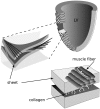Anisotropy of wave propagation in the heart can be modeled by a Riemannian electrophysiological metric
- PMID: 20696934
- PMCID: PMC2930580
- DOI: 10.1073/pnas.1008837107
Anisotropy of wave propagation in the heart can be modeled by a Riemannian electrophysiological metric
Abstract
It is well established that wave propagation in the heart is anisotropic and that the ratio of velocities in the three principal directions may be as large as v(f)v(s)v(n) approximately 4(fibers)2(sheets)1(normal). We develop an alternative view of the heart based on this fact by considering it as a non-Euclidean manifold with an electrophysiological(el-) metric based on wave velocity. This metric is more natural than the Euclidean metric for some applications, because el-distances directly encode wave propagation. We develop a model of wave propagation based on this metric; this model ignores higher-order effects like the curvature of wavefronts and the effect of the boundary, but still gives good predictions of local activation times and replicates many of the observed features of isochrones. We characterize this model for the important case of the rotational orthotropic anisotropy seen in cardiac tissue and perform numerical simulations for a slab of cardiac tissue with rotational orthotropic anisotropy and for a model of the ventricles based on diffusion tensor MRI scans of the canine heart. Even though the metric has many slow directions, we show that the rotation of the fibers leads to fast global activation. In the diffusion tensor MRI-based model, with principal velocities 0.25051 m/s, we find examples of wavefronts that eventually reach speeds up to 0.9 m/s and average velocities of 0.7 m/s. We believe that development of this non-Euclidean approach to cardiac anatomy and electrophysiology could become an important tool for the characterization of the normal and abnormal electrophysiological activity of the heart.
Conflict of interest statement
The authors declare no conflict of interest.
Figures




Similar articles
-
Timing of depolarization and contraction in the paced canine left ventricle: model and experiment.J Cardiovasc Electrophysiol. 2003 Oct;14(10 Suppl):S188-95. doi: 10.1046/j.1540.8167.90310.x. J Cardiovasc Electrophysiol. 2003. PMID: 14760923
-
Electrical wave propagation in an anisotropic model of the left ventricle based on analytical description of cardiac architecture.PLoS One. 2014 May 9;9(5):e93617. doi: 10.1371/journal.pone.0093617. eCollection 2014. PLoS One. 2014. PMID: 24817308 Free PMC article.
-
[Numerical Simulation of Propagation of Electric Excitation in the Heart Wall Taking into Account Its Fibrous-Laminar Structure].Biofizika. 2015 Jul-Aug;60(4):748-57. Biofizika. 2015. PMID: 26394475 Russian.
-
Uncertainty quantification of fast sodium current steady-state inactivation for multi-scale models of cardiac electrophysiology.Prog Biophys Mol Biol. 2015 Jan;117(1):4-18. doi: 10.1016/j.pbiomolbio.2015.01.008. Epub 2015 Feb 7. Prog Biophys Mol Biol. 2015. PMID: 25661325 Free PMC article. Review.
-
Imaging-based integrative models of the heart: closing the loop between experiment and simulation.Novartis Found Symp. 2002;247:129-41; discussion 141-3, 144-50, 244-52. Novartis Found Symp. 2002. PMID: 12539953 Review.
Cited by
-
Lessons from computer simulations of ablation of atrial fibrillation.J Physiol. 2016 May 1;594(9):2417-30. doi: 10.1113/JP271660. Epub 2016 Mar 4. J Physiol. 2016. PMID: 26846178 Free PMC article. Review.
-
Gaussian Process Regressions for Inverse Problems and Parameter Searches in Models of Ventricular Mechanics.Front Physiol. 2018 Aug 14;9:1002. doi: 10.3389/fphys.2018.01002. eCollection 2018. Front Physiol. 2018. PMID: 30154725 Free PMC article.
-
Model order reduction for left ventricular mechanics via congruency training.PLoS One. 2020 Jan 6;15(1):e0219876. doi: 10.1371/journal.pone.0219876. eCollection 2020. PLoS One. 2020. PMID: 31905197 Free PMC article.
-
A computational model predicts adjunctive pharmacotherapy for cardiac safety via selective inhibition of the late cardiac Na current.J Mol Cell Cardiol. 2016 Oct;99:151-161. doi: 10.1016/j.yjmcc.2016.08.011. Epub 2016 Aug 18. J Mol Cell Cardiol. 2016. PMID: 27545042 Free PMC article.
-
A Phase Defect Framework for the Analysis of Cardiac Arrhythmia Patterns.Front Physiol. 2021 Sep 22;12:690453. doi: 10.3389/fphys.2021.690453. eCollection 2021. Front Physiol. 2021. PMID: 34630135 Free PMC article.
References
-
- Winfree AT, Strogatz SH. Organizing centers for three-dimensional chemical waves. Nature. 1984;311:611–615. - PubMed
-
- Mehra R. Global public health problem of sudden cardiac death. J Electrocardiol. 2007;40:S118–S122. - PubMed
-
- LeGrice IJ, et al. Laminar structure of the heart. II. Mathematical model. Am J Physiol. 1995;269:H571–H582. - PubMed
-
- Caldwell BJ, et al. Three distinct directions of intramural activation reveal nonuniform side-to-side electrical coupling of ventricular myocytes. Circ Arrhythm Electrophysiol. 2009;2(4):433–440. - PubMed
Publication types
MeSH terms
LinkOut - more resources
Full Text Sources
Other Literature Sources

